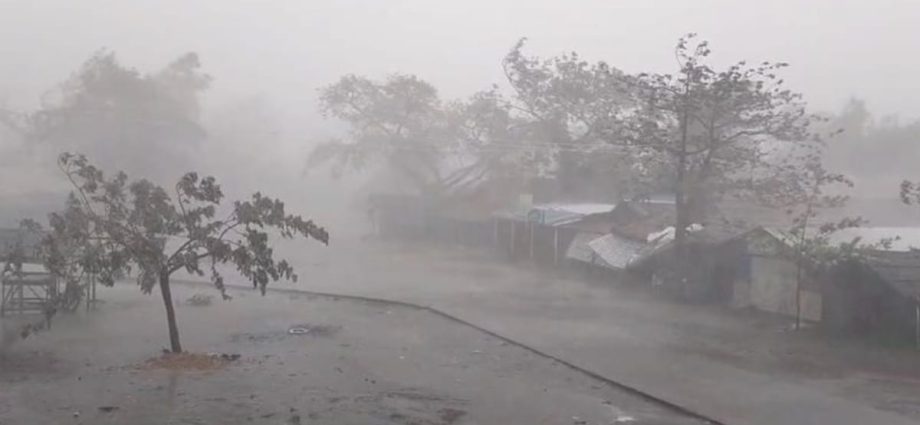
It was not clear whether any of them were included in the death toll in the junta’s statement.
Mocha made landfall on Sunday, bringing a storm surge and high winds that toppled a communications tower in Sittwe, according to images published on social media.
“I was in a Buddhist monastery when the storm came,” one resident told AFP.
“The prayer hall and monk dining hall have collapsed. We had to move from this building and that building. Now roads are blocked as trees and pylons are fallen.”
Junta-affiliated media reported that the storm had put hundreds of base stations, which connect mobile phones to networks, out of action in Rakhine.
Junta chief Min Aung Hlaing had “instructed officials to make preparations for Sittwe Airport transport relief”, state media reported, without giving details on when relief was expected to arrive.
“EXTENSIVE DAMAGE”
The United Nations said communications problems meant it had not yet been able to assess the damage in Rakhine, which has been ravaged by ethnic conflict for years.
“Early reports suggest the damage is extensive,” the UN Office for the Coordination of Humanitarian Affairs said late on Sunday.
On Bangladesh’s Shah Porir Dwip island, residents began repairing damaged homes, searching through debris and retrieving scattered possessions.
Bangladesh officials said they had evacuated 750,000 people.
Secretary of the disaster management ministry, Kamrul Hasan, told AFP on Monday no one had died in the cyclone.
The damage was also minimal in the Rohingya camps, where about a million people live in 190,000 bamboo and tarpaulin shelters, officials said.
“About 300 shelters were destroyed by the cyclone,” deputy refugee commissioner Shamsud Douza told AFP.
The chances of landslides in the camps were also low “due to lack of rain”.
“The sky has become clear.”
Jomila Banu, a 20-year-old Rohingya woman from Nayapara refugee camp at Teknaf, said: “The roof of my home has been blown away by the wind, now I am eating rice under the open sky with my children.”
“The sound and force of the wind made it seem like we would not survive,” she told AFP.
Better forecasting and more effective evacuation planning have dramatically reduced the death toll from such storms in recent years.
Scientists have warned that storms are becoming more powerful as the world gets warmer because of climate change.
Cyclones – the equivalent of hurricanes in the North Atlantic or typhoons in the Northwest Pacific – are a regular and deadly menace on the coast of the northern Indian Ocean where tens of millions of people live.
Cyclone Nargis devastated Myanmar’s Irrawaddy Delta in 2008, killing at least 138,000 people.
The then-junta faced international criticism for its response to the disaster. It was accused of blocking emergency aid and initially refusing to grant access to humanitarian workers and supplies.

